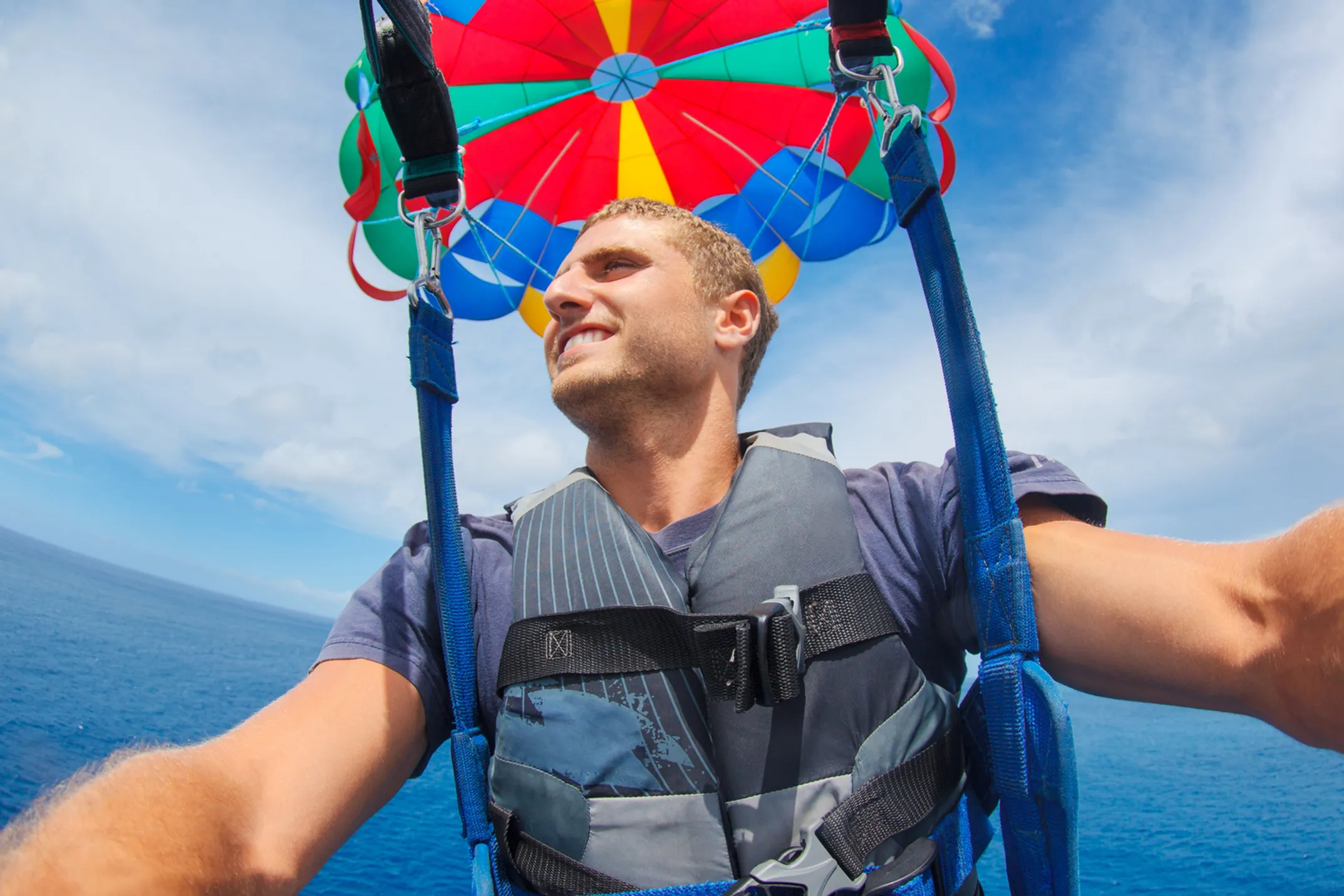

Parasailing Safety Guide
Flying with confidence: How to choose a safe operator in Hawaii

Written by a Local Expert
Jade KawanuiFlying with Confidence: Your Safety First
Parasailing is very safe statistically, with millions of flights done every year without problems. That safety record comes from strict standards, professional crews, and well-kept equipment. Knowledge is the best way to make sure you pick an operator who puts your safety first.
The difference between a safe flight and a potential problem often comes down to checks and standards that good companies follow without compromise. This guide will help you identify operators who prioritize safety above all else.
The Golden Rule: Weather is Everything
Weather is the most important factor in parasailing safety. Good operators won't fly in unsafe conditions. Industry standards from groups like the Water Sports Industry Association and ASTM International ban operations in steady winds over 20-25 mph or high seas.
✅ Safe Weather Conditions
- Steady winds under 20 mph
- Calm to moderate seas (1-3 ft)
- Good visibility (no fog/storms)
- No lightning within 10 miles
🚩 Dangerous Conditions
- Winds over 25 mph sustained
- Rough seas (4+ ft swells)
- Storms or heavy rain
- Gusty, unpredictable wind patterns

The Lifeline: Equipment Inspection
Equipment condition is critical. While you might not be an expert, you can look for basic signs of a well-run operation that follows industry maintenance standards.
🔍 Equipment Safety Checklist
The Boat
- Purpose-built parasail boat with winch system
- Flight deck at the back, not regular speedboat
- Clean, well-maintained appearance
- Required Coast Guard safety equipment visible
Safety Gear
- Towline looks clean, no visible fraying
- Harnesses without torn fabric or broken buckles
- Life jackets in good condition
- Parachute shows no sun damage or repairs
The Captain and Crew: The Professionalism Test
The crew is the most important safety feature. The boat captain must be licensed by the U.S. Coast Guard to carry passengers for money. The whole crew should be professional, confident, and focused on safety.
Safety Briefing
- Clear, unhurried explanation
- Covers all equipment
- Hand signals explained
- Questions welcomed
Captain Credentials
- USCG licensed captain
- Years of experience
- Local knowledge
- Confident demeanor
Crew Behavior
- Professional appearance
- Focused on safety
- Clear communication
- No rush or pressure
Ready to Choose a Safe Operator?
Use this safety checklist when booking your parasailing adventure and get answers to common safety questions.
🏆 Look for These Certifications
U.S. Coast Guard licensed captains & certified boats
Water Sports Industry Association standards
Professional Association of Parasail Operators
🚩 Red Flags to Avoid
- Rushed briefing
Incomplete or dismissive safety explanation
- Poor equipment
Frayed ropes, old gear, makeshift repairs
- Weather pushing
Operating in borderline conditions
- No credentials
Can't answer questions about licensing
🏝️ Hawaii-Specific Rules
Dec 15 - May 15: Complete closure
Ocean Recreation Management Areas only
Dept. of Land & Natural Resources licensing
Understanding the Alphabet Soup of Safety: USCG, WSIA, PAPO
You might see these letters mentioned by operators. They show professionalism and high standards that go beyond basic legal requirements.
USCG (U.S. Coast Guard)
The federal group that licenses captains and certifies boats for commercial use, making sure they meet federal safety requirements. A USCG-licensed captain has passed rigorous testing on navigation, safety, and maritime law.
What to look for: Ask to see the captain's license, which must be displayed or readily available. Commercial boats must also display their Certificate of Inspection.
WSIA (Water Sports Industry Association)
A key trade group that works with the Coast Guard and ASTM International to develop industry-wide safety standards and best practices, including guidelines for weather monitoring and equipment maintenance.
What to look for: WSIA member operators often display membership certificates and follow stricter safety protocols than legally required.
PAPO (Professional Association of Parasail Operators)
A self-regulating group of operators committed to strict ethics and safety guidelines, similar to how PADI sets scuba diving standards. Membership shows commitment to safety beyond basic legal requirements.
What to look for: PAPO members typically have better safety records and follow standardized procedures for equipment maintenance and crew training.
| Safety Check | ✅ Green Light (What to Look For) | 🚩 Red Flag (What to Avoid) |
|---|---|---|
| Crew Professionalism | Clear, unhurried safety briefing; confidently answers questions; appears focused and professional | Rushed or incomplete briefing; dismissive of questions; seems distracted or unprofessional |
| Boat & Equipment | Clean, purpose-built winch boat; gear looks new or well-maintained; no visible rope fraying | Regular speedboat (not winch boat); equipment looks old, frayed, or rusty; makeshift repairs |
| Weather Policy | Actively monitors weather; willing to cancel or reschedule for high winds or rough seas | Pushing limits in borderline conditions; pressuring you to fly despite concerns |
| Certifications | Mentions Coast Guard licensed captains; may advertise WSIA or PAPO membership | No mention of licenses or professional groups; can't answer questions about qualifications |

